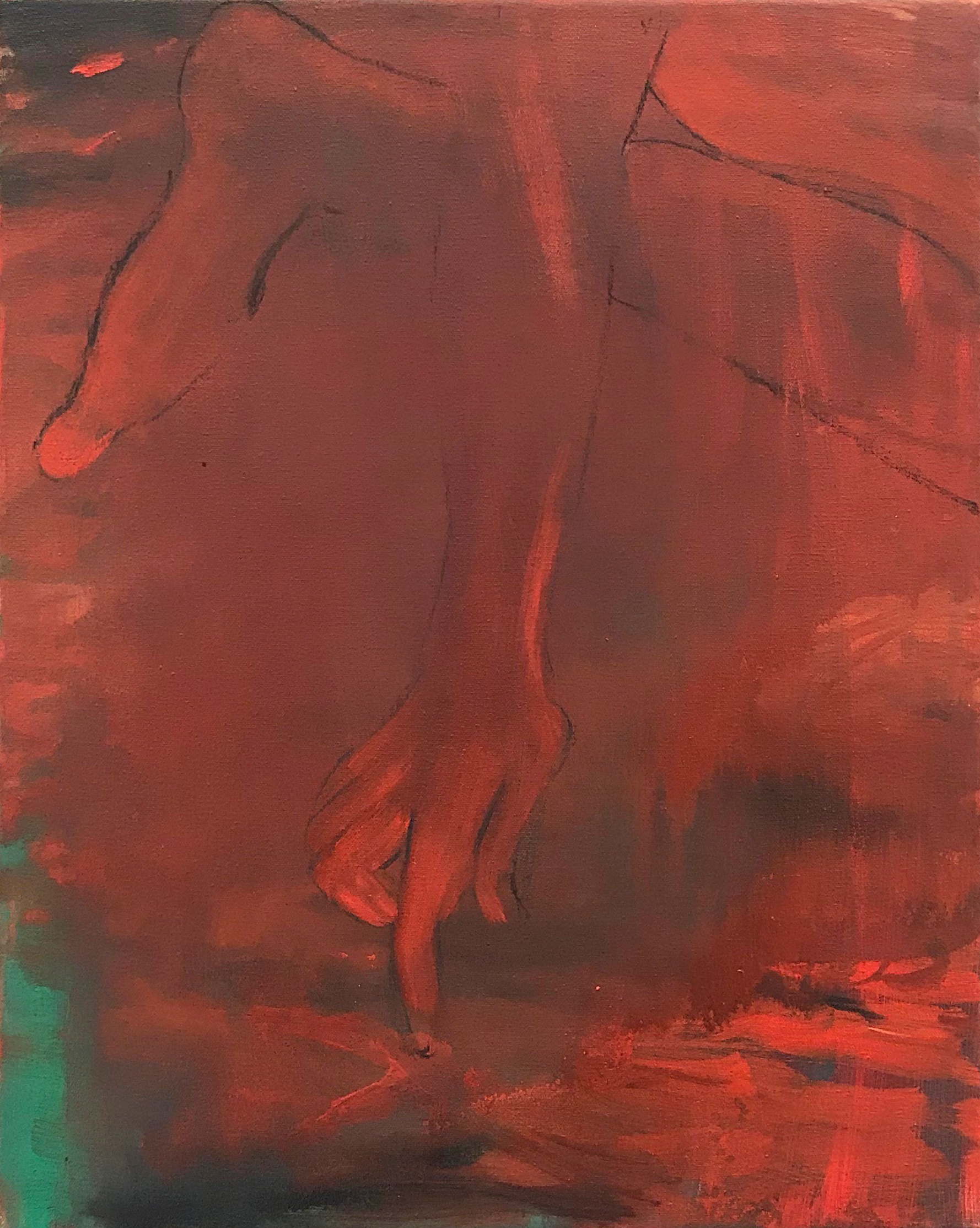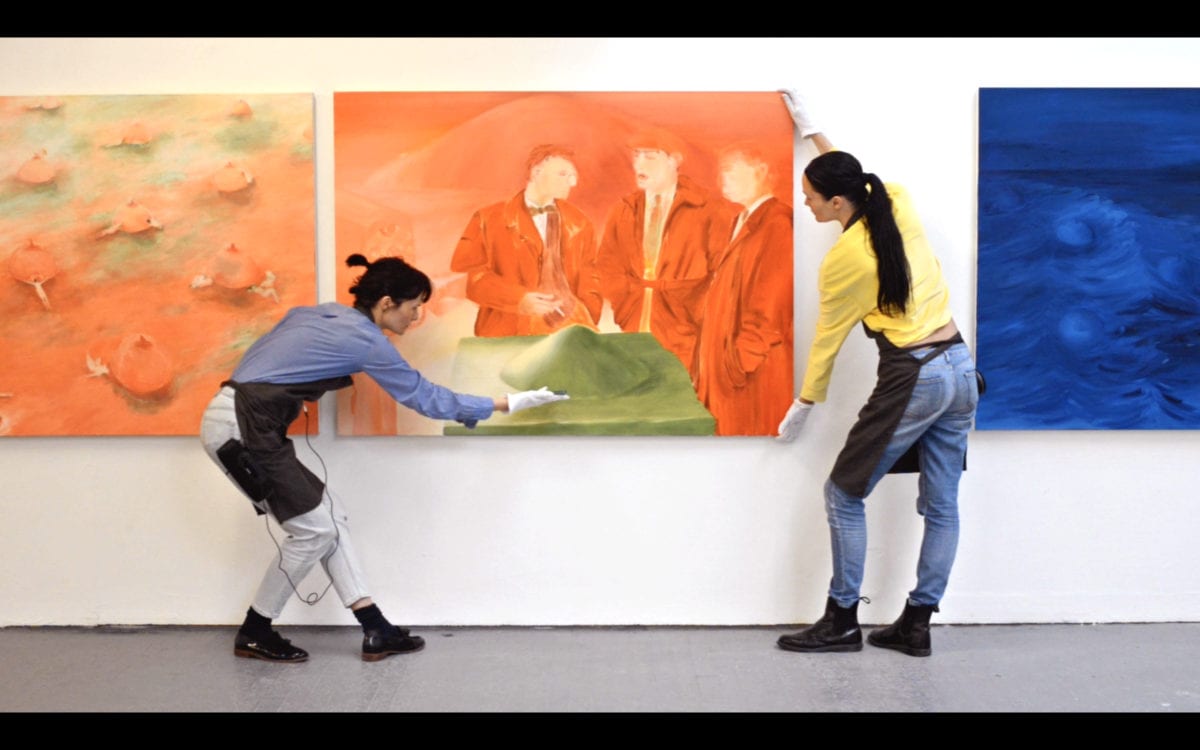
I first came across Amy Steel‘s work at this year’s Slade MFA show, where her glowing orange painting of a human with a rabbit’s head commanded the room. There was something sensual, but also something kind of freaky and kind of funny about it. However, when I later discovered that the paintings were part of a performance where Steel and another performer posed with the paintings like slightly absurd art handlers, they were elevated into a wholly sensory experience. I chatted with the artist about sexuality, Samuel Beckett and the post-human body.

The colour palette of your paintings seems to alternate between a searing neon pink/orange and a deep blue. Do you see these two palettes as different states or moods?
I do see these two palettes as offering different moods. My use of deep blue is often working to create the feeling of a more reflective, inward mood. I think there is a peacefulness to the blue paintings and space for contemplation. The intense pink/orange I see as being more outward and bringing bodily sensations. I use these colours as a force that surges through the body. Colour works on our senses and emotions, and for me it is tactile.
I like that, by using an intense and exaggerated colour there is a sense that things are transitional, what we are seeing is suspended in a temporary state of arrest. For me this keeps the painting feeling alive.

“Colour works on our senses and emotions, and for me it is tactile”
You also have a performance element to your practice—in The Handlers, performers interacted with your paintings at the Slade MFA show. Is it important for you that paintings be activated?
I am very interested in using performance to activate paintings because I see it is an opportunity to create more layers of meaning, and to disrupt the very fixed system of representation that often surrounds painting.
For a long time I had been looking at images of paintings at auction houses such as Christie’s and Sotheby’s. I was fascinated by how subtly dramatic and choreographed the gestures of art handlers appear as they stand either side of a painting. For me, they added something to the painting; they became a part of the painting and often brought out a central element of the painting further.
I think a good painting makes me want to do something. I thought to myself that, if I were an art handler standing beside these paintings all day long, I would have a million impulses surging through my body. It became a structural part of the performance to explore what those gestures could be. In the performance The Handlers, paintings are kissed; taken off the wall at the sound of an earthquake; mobile phones are placed at figures mouths etc. The performance creates a situation of irreverence towards established modes of display and also expected behaviour.
I want the paintings to be handled in a way that feels unexpected and takes the viewer by surprise. By using sound along with gesture different senses are activated; the overall sensory experience becomes fuller and stranger! I think that activating the paintings also works to include a wider audience, many people have spoken to me about not being interested in painting, but through the performance they became interested and felt included in a medium that they previously felt outside of or thought didn’t interest them.
- The Handlers, 2019 (Performance stills)
What role does sexuality play in your work?
Sexuality plays an important role in my work because I am attempting to visualize a female erotic. I am very interested in the sensuality of the body. I think there is a desire to be connected to things in my work: to my body, to others, to objects around me and the spaces I find myself in. I see this desire for interconnectedness to be in direct relation to the subject of sexuality because I am interested in framing sensuality as the connective tissue between things.

“I think there is a desire to be connected to things in my work: to my body, to others, to objects around me”
Is your work informed by any literature or other areas of culture?
I feel that many cultural references seep into and inform my work. It is hard sometimes to really know where things are coming from because we are surrounded by so much stimulation.
I was an actor before I came to the visual arts. I would say that theatre has had a lasting influence on me. Some years ago I saw Beckett’s Not I, a play that is a fifteen-minute-long monologue spewed out at lighting speed. Only a mouth is visible to the audience and everything else is in total blackness. The mouth appears to float about the stage. I was mesmerized by this image.
The piece interpreted visually ideas that feel close to me, such as the woman, the “I”, not being a single or specific woman but being an entity, part of a stage image. In my paintings and performance the bodies don’t feel like individual identities; they are a collective body, a performing body. I often feel that the bodies I am interested in are what is termed a post-human body, one that’s not limited by its own parameters or its identity or gender type. Duality and multiplicity of entities are very important to me. In Not I the mouth is both a subject and an object; this also has a recurring presence in my work.

Days Done, 2019
There was a recurring element of metamorphosis at your Slade show, with body parts becoming fruits, buoys and bunnies. Traditionally, typically female body parts are often referred to as various fruits. What your feelings about this? Do you see it as positive or negative, or somewhere in between?
That’s funny, I don’t see fruits metamorphosing into body parts in any of my paintings. However, I am using landscape, bunnies and other sources from nature as recurring elements. I think working with metaphors that use nature in relation to women’s bodies and identities can obviously be problematic. These metaphors are mostly inherited from a patriarchal visual language. However, I am interested in how I can bring expansion to the image of this metaphor. I think a significant factor for me in my own work is that I am using this imagery that connects women’s bodies to nature not as a visual substitution or shorthand for female sexuality, but rather as a tactile language through which female sexuality can be explored.
I think this is why the sense of touch and colour are very important in the paintings because they bring together this tactile language for the viewer to experience the painting. When I am making the paintings, the swirling breast shaped mounds, protruding nipples and rabbits soft fur feel close to me as though they brush softly against my skin, while blasted intense pink/oranges create sensations of heat in me. I feel overwhelmed by these colours at times. I hope that the viewer can experience some of this language in the paintings, and that they are therefore offering an alternative to the male gaze.








